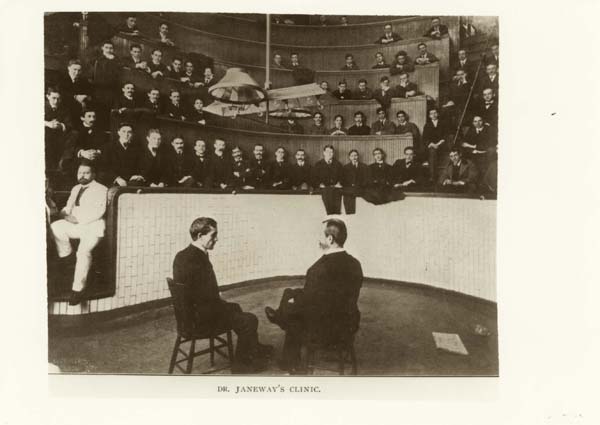
Commentary by Deena Altman MD, PGY-2
Please also see the clinical vignette presented before grand rounds on February 18th.
At medical grand rounds on February 18, 2009, our very own Dr. Pillinger gave a unique overview of the history, pathogenesis, and new theories on an ancient and increasingly common disease, gout.
His talk began with a depiction of gout throughout the ages. Podagra was first described in 2600 BC, with the first urate crystals being recognized in 1961 by polarizing microscope. While noting that Charles Darwin apparently suffered from gout, Dr. Pillinger outlined several of the proposed evolutionary mechanisms thought to have kept gout around. One theory is that uric acid has a beneficial anti-oxidant property. Uric acid may also act as a “danger signal” for the immune system, alerting dendritic cells to the presence of damaged or infected neighbors. Another proposal is related to uric acid’s link to blood pressure. It is a well established fact that humans and many other primates, including the great apes, have more uric acid than most other mammals, and that this increase in uric acid relates to the loss of uricase, an enzyme that degrades uric acid to allantoic acid. It is possible that the loss of uricase helped primates survive the harsh Miocene era, characterized by low salt diets and vulnerability to hypotension. By acting on the kidneys and vascular, elevated levels of urate may have helped primates maintain their blood pressures to a level necessary for survival. In fact, several preliminary studies suggest that allopurinol, the classic urate-lowering drug, may lower blood pressure in vulnerable hyperuricemic patients.
The incidence of gout is on the rise, having roughly quadrupled since the 1970s. Today, an estimated two percent of the general population suffers from gout. We are part of an aging, obese society with a diet of meat and alcohol which have contributed to a rise in uric acid levels over time. The increase in our daily intake of high fructose corn syrup, in soft drinks and processed foods, has been shown in some studies to to have a dose-dependent association with increased serum uric acid levels, particularly in men. This effect is not seen in diet drinks. Interestingly, coffee consumption may be associated with lower uric acid levels. Among alcoholic beverages, the main alcoholic culprit is beer, which has high purine content, while wine, which has anti-oxidant properties, has much less effect on uric acid levels, particularly at moderate levels of consumption.
Dr. Pillinger concluded the presentation with an overview of various treatments, old and new, for gout. Classically, steroids, colchicine, and non-steroidal anti-inflammatory agents have been utilized to reverse or prevent acute attacks. Probenecid and allopurinol, which work to lower uric acid levels, are also commonly employed. Febuxostat, approved in mid-February, is a non-purine xanthine oxidase inhibitor, that has been shown to be more selective than allopurinol and lowers uric acid levels approximately as well as allopurinol, with a longer half life. It is potent, simpler to use, relatively safe in renal patients, but more expensive than allopurinol. Rasburicase, a drug used more often for tumor lysis syndrome, has also been used to lower uric acid levels in refractory patients; rasburicase has many side effects, but a mammalian recombinant uricase, puricase, is under development and may become available in the future. Other new agents being investigated, include targeting NALP-3 inflammasome, caspase 1, along with others inflammatory regulators, which we may see in the near future.
From ancient history to cutting edge treatments, Dr. Pillinger’s lecture gave us all an enlightening review of gout.

One comment on “Grand Rounds: Gout and Hyperuricemia: Some New Thoughts About an Old Disease”
One aspect of gout which is too often overlooked is that most gout flares are initiated during sleep. The sleep connection has been known at least since Dr. Thomas Sydenham wrote about it in 1683. It is a very important clue to the pathogenesis of gout.
Most gout flares are a direct result of sleep apnea, and overcoming the sleep apnea can cure the gout. The hypoxemia of sleep apnea has three effects which lead to an overnight gout flare in short order. Effect #1 is cellular catabolism in which ATP degradation is accelerated, culminating irreversibly in the cellular generation of excess uric acid fed into the blood, faster than any food would cause. Effect #2 is hypercapnia and acidosis, so that the blood can hold less uric acid in solution. Effect #3 is a long term acceleration of the deterioration of the kidneys’ glomerular filtration rate so that removal of uric acid from the blood is slowed. Thus, with sleep apnea there is an abrupt increase in the influx of uric acid in the blood, slowed efflux, and reduced storage capacity — perfect storm conditions for monosodium urate precipitation. Furthermore, after awakening and normal breathing is restored, the first two effects dissipate so that a blood test taken during waking hours misses their peaks.
Gout experts should feel embarrassed for having missed this connection for so long, especially since gout has been reported to have so many of the same comorbidities already known to be consequences of long-term untreated sleep apnea (eg., cardiovascular diseases, hypertension, diabetes, kidney disease.) One of the first steps for treating gout should be screening and diagnosis for sleep apnea, followed by treatment of the sleep apnea where indicated. I know from my own experience and the experiences of others that overcoming sleep apnea can prevent additional inflammatory gout flares immediately. More importantly, gout is an early warning of sleep apnea, which when heeded can lead to the early treatment of sleep apnea, thereby greatly reducing the risk for the development of sleep apnea’s life-threatening consequences.
Comments are closed.